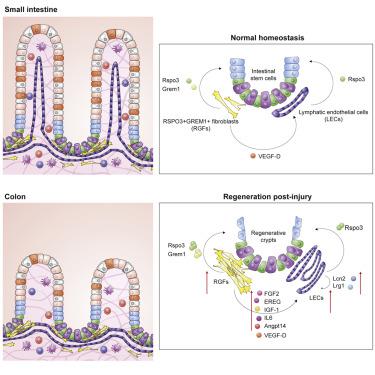Cell Stem Cell ( IF 23.9 ) Pub Date : 2022-08-04 , DOI: 10.1016/j.stem.2022.06.013 Norihiro Goto 1 , Saori Goto 1 , Shinya Imada 1 , Sahar Hosseini 2 , Vikram Deshpande 2 , Ömer H Yilmaz 3

|
Lgr5+ intestinal stem cells (ISCs) depend on niche factors for their proper function. However, the source of these ISC niche factors and how they support ISCs in vivo remain controversial. Here, we report that ISCs depend on lymphatic endothelial cells (LECs) and RSPO3+GREM1+ fibroblasts (RGFs). In the intestine and colon, LECs are surrounded by RGFs and are located near ISCs at the crypt base. Both LECs and RGFs provide the critical ISC niche factor RSPO3 to support ISCs, where RSPO3 loss in both cell types drastically compromises ISC numbers, villi length, and repair after injury. In response to injury, LEC and RGF numbers expand and produce greater amounts of RSPO3 and other growth/angiocrine factors to foster intestinal repair. We propose that LECs represent a novel niche component for ISCs, which together with RGFs serve as the major in vivo RSPO3 source for ISCs in homeostasis and injury-mediated regeneration.
中文翻译:

淋巴管和成纤维细胞支持肠道干细胞的稳态和损伤
Lgr5 +肠道干细胞 (ISC) 的正常功能依赖于生态位因子。然而,这些 ISC 生态位因子的来源以及它们如何在体内支持 ISC仍然存在争议。在这里,我们报告 ISC 依赖于淋巴内皮细胞 (LEC) 和 RSPO3 + GREM1 +成纤维细胞 (RGF)。在肠道和结肠中,LEC 被 RGF 包围,并且位于隐窝基底的 ISC 附近。LEC 和 RGF 都提供关键的 ISC 生态位因子 RSPO3 来支持 ISC,其中两种细胞类型中 RSPO3 的丢失会极大地影响 ISC 数量、绒毛长度和损伤后的修复。为了应对损伤,LEC 和 RGF 数量会增加并产生更多的 RSPO3 和其他生长/血管分泌因子,以促进肠道修复。我们认为LEC代表了ISC的一种新的利基成分,它与RGF一起作为ISC在稳态和损伤介导的再生中的主要体内RSPO3来源。


























 京公网安备 11010802027423号
京公网安备 11010802027423号